To celebrate the recent passage of the suction dredging bill and in an effort to remove myself from the computer, a friend of mine Kyle who works for a local watershed council and I decided to paddle down the Willamette River from Eugene to Independence Oregon, just south of Salem. Growing up paddling in the Ozarks, I had been missing these types of excursions, and jumped at the chance to camp on gravel bars for a few nights. We took advantage of some days off for the Fourth of July weekend and borrowed a Wenonah Spirit (17 foot all-purpose canoe). We planned for three nights of meals and four days on the river and after realizing we forgot a stove, resolved to cook over fires.
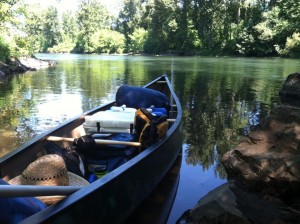
We put in at Armitage State Park in Springfield, actually on the McKenzie River, only a couple of miles from the confluence with the Willamette. I was hoping we would get to shoot the roller under Autzen Bridge on the way through Alton Baker Park, but I realized later that my friend had purposely avoided this route, likely in an effort to preserve his expensive fly-fishing gear that was brought along.
This first stretch of the river contained a fair deal of fast water, and some narrow turns, the first of which almost spilled us as I turned the bow a little too soon and caught an eddy current that put the edge of the boat on the water line, and turned us 280 degrees. The Willamette took some time for me to adjust too, the sheer quantity of water forces you to prepare your turns much earlier, and I eventually learned to prepare my line far before a large strainer was upon us.
We entirely spaced the confluence between the McKenzie and the Willamette, but apparently it is not that significant. It consisted of at least two separate smaller streams feeding into the main channel of the McKenzie, but shortly after realizing we had missed the confluence, we noticed that the river had gotten much larger.
The first night we camped about ten miles south of Corvallis, west of Brownsville. We had found an excellent large gravel bar on a secluded stretch of the river, figured it was around 5 or 6 (we put in at 11am), and gathered plentiful drift wood for a nice fire to clear any bugs and prepare dinner. It was the fourth and we were camped at a bend in the river allowing us to see up at least a couples of miles of straight river that pointed to Corvallis. After a horrible dinner of mac and cheese and hot dogs (‘merica) that settled like an enormous stone in our stomachs and set the stage for emergency pull-overs the next day, we played some cribbage and luckily we able to catch the majority of the firework show in Corvallis that was above the tree line.
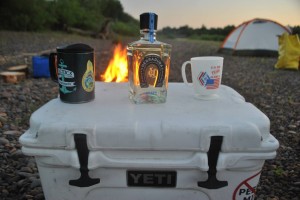
We had plenty of wood leftover for coffee and bacon in the morning (make sure to bring some sort of work gloves when cooking over open flames) and got on the water relatively early in an effort to catch some wildlife. The river has slowed a fair deal, which allowed Kyle to fish from the bow, although apparently the fishing is not very good that far north. We stumbled upon a lot of blue herons, bald eagles, kingfishers, the occasional deer, and frequently spotted fish swimming alongside the boat. This early stretch of the river was filled with beautiful large gravel bars, plenty of nice camping spots, and good looking river banks.
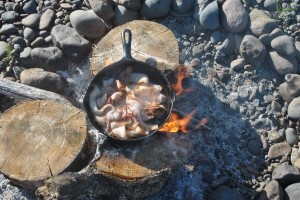
We soon passed through Peoria and Corvallis, where the Willamette is joined by the Marys River. We were joined on the river by some partying college students that were enjoying the sun. After Corvallis we also noticed a couple of motor boats on the water; we were passed by a large police boat that despite our efforts decided to corner the flotilla of OSU kids. Aside of the riverside parks after the confluence with the Calapooia (Kyle’s watershed council), the river began to take on a totally different look. Very agricultural, prominent erosion on the banks and every once in a while, a large piece of rusting farm equipment half submerged. The water had slowed dramatically; we figured we were covering around 2 miles an hour with slight paddling. Camping opportunities, aside from crowded boat ramp parks, became scarce in this section as well. As the day wore on, we became slightly worried about finding a decent gravel bar to post-up on. We decided to push through Albany, and attempt to hit a two-mile long island that we were confident would have some camping.
We were not making good time and as the sun started to approach the tree-line, we started paddling hard in an effort to find this ominously self-titled island. We reached the island as the sun was setting. We beached the boat at the tip of the island, and hiked around briefly to decide where to camp. There was a great spot, although boggy, on the east side of the island, which also shielded us from the noise of the road on the far west bank of the river. We quickly gathered some wood, and started a smoky fire to keep away the bugs we knew the frequent pools were sheltering , and given the hard paddling for the past few hours, elected to cook our ribeyes and twice baked potatoes that I had prepared and wrapped in foil days before. Kyle retied early, but I decided to prop myself up in two camping chairs and weather the night next to the fire. The north portion of the island had a large stand of cottonwoods and firs, that as I soon realized, harbored an enormous bat population. Watching the stars, I felt like I was looking through a screen door there were some many bats preying on the bugs those pools were producing. There was also a beaver nearby that I heard throughout the night, who was also evidenced by the nice chewed on hardwood sticks I was using to fuel the fire. In the morning we prepared coffee and bagel and sausage sandwiches. After a morning swim, we were able to load the canoe quickly and hit the water.
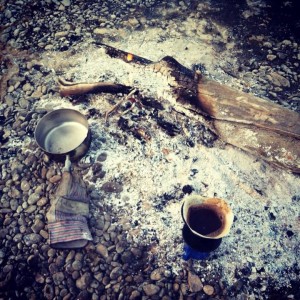
Just several miles north of our camp spot we hit the confluence of the Santiam River, which was marked by an enormous and awesome gravel bar. This stretch of the river altered dramatically as well. The agricultural traces began to fade and we began to come across large bluffs and gravel bars. Having made good time the following day, we stopped and enjoyed the sun for a bit and got in some more fishing. We also took a lot of time to fish the frequent sloughs along the river. These sloughs were sluggish, frequently dead-ending, side-channels of the river. Kyle was sight fishing for carp, looking for murky disturbances in the water (sign of feeding), attempting to spot the three feet fish scared out by our shadow, and then dropping the line right in front of the fish in hopes it would take hold. We had several good opportunities, but never landed one. It was incredible to see these huge fish, in these very shallow and isolated back channels, where they spend their entire lives.
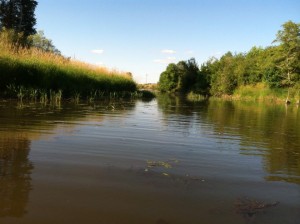
Despite resting the majority of the day on improvised dry-bag back rests, we still arrived at our take out in Independence that third night, where there was no camping allowed. We had totaled around 90 miles in three days, likely averaging around 3-4 miles per hour. There is a big fourth celebration in Independence, Oregon (given the name) on that Saturday night and allow tempted to stay and experience the town, we decided to load up the car and head back into Eugene for the evening. All in all it was an incredible trip and novel way to spend a holiday. I was amazed by the resilience of this heavily abused river that has been able to recover quickly and still provide an easy escape from town. What’s the saying: “Nature bats last.”


